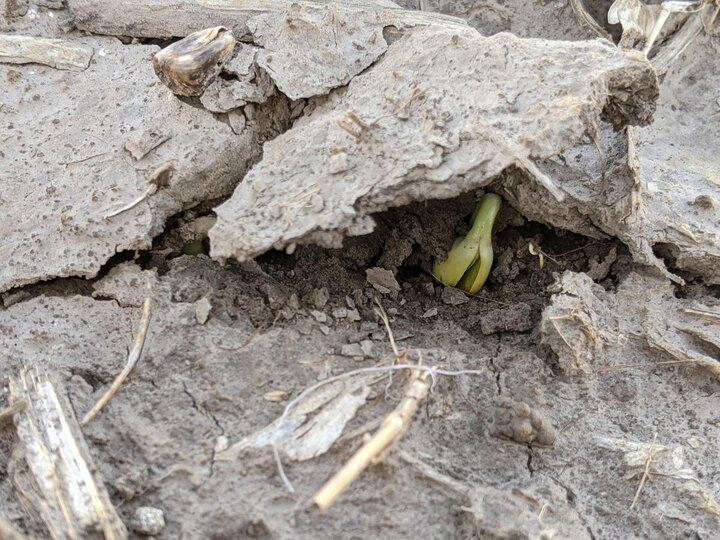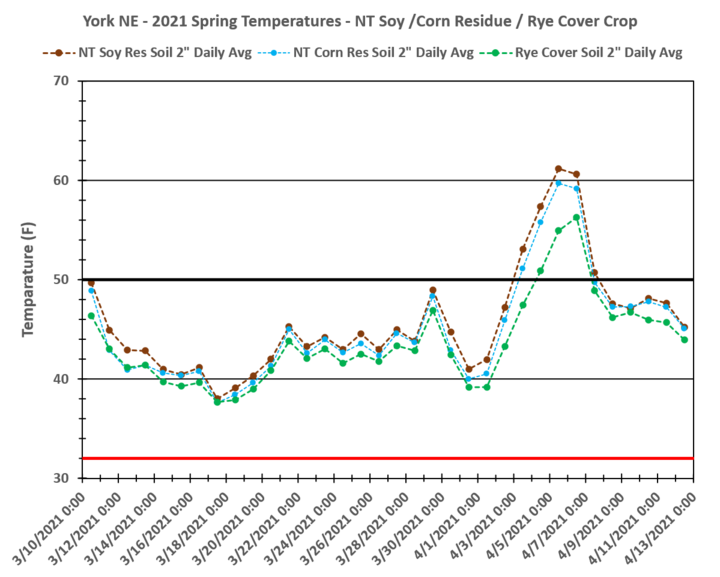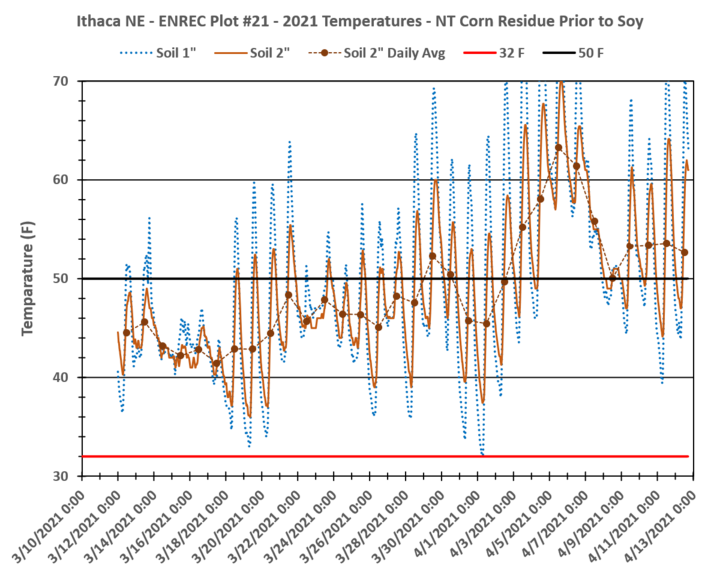
With March often providing opportunities for higher soil temperatures, we began indoor and outdoor demonstrations to better determine the critical soil temperatures and trends of these temperatures for soybean germination and emergence. The following article shares results thus far of our field demonstrations in addition to early soybean planting considerations. Please see "Demonstrating Critical Imbibition Time for Soybean" for results of our indoor demonstration.
Field Demonstration
In the field demonstrations, soil temperature probes were placed at 2" deep in the soil below corn residue, soybean residue and living cereal rye. Air temperature was also measured at 12" above the soil line. Seeds (50 at York and 25 at Ithaca) were planted on days conducive for planting (not raining) and that worked into the authors’ schedules with the first planting date of March 10 (York) and March 12 (Ithaca), 2021.
Outdoor Demonstration Results
As of April 13, 2021, soybeans planted at earliest planting dates (March 10 in York and March 12 in Ithaca) had cracked the soil surface, but seedlings had not yet emerged enough for an emergence count (Figure 1). Soybean at both locations were planted into the old corn residue at a 2" depth. Viewing the soil and air temperature charts, there were daily periods when the daily minimal soil temperature at both locations were at least 45°F, followed by a warming trend. There are also periods where the soils cooled after a brief warm cycle.
Not unexpectedly, the soil at 2" below the soybean residue was a couple of degrees warmer than the soil under the corn residue at both locations (Figures 2 and 3). The soil at 2" below the growing cereal rye (currently 15-18" tall) at York was cooler than that under the soybean and corn residue. We will share more information on these correlations later upon soybean emergence and stand counts after the various planting dates.




Early Planting Considerations
- Avoid planting soybean when a cold rain and cold snap is expected within 24 hours (safer within 48 hours). Soil temperatures can be directly tracked in the farm field with a meat thermometer or at Nebraska weather station sites (https://cropwatch.unl.edu/soiltemperature). To get hourly updated current air and soil temps at those same sites, check out Nebraska Mesonet.
- When possible, consider planting soybean in the warmer part of the day (Figures 2-4 show highest air temperatures during spring occur in early afternoon) or when air temperatures are generally warming.

- Plant into moist but not saturated soils. The imbibitional phase may complete without chilling injury in cooler soils (45°F) if the soil is moist, but not saturated, assuming no cold rains/cold snaps occur within 24 hours. Some soil-borne pathogens can thrive in cool saturated soils and can impede germination and/or cause seedling death.
- Plant 1.5-2” deep to allow for buffered soil moisture and temperature conditions. The buffered temperature can be seen in Figure 4 when comparing soil temperature at 1” vs. 2” under no-till corn residue. UNL research found lowest yields when soybean was planted 1.25 inches deep or less, or 2.25 inches or greater with the highest yield at 1.75 inches deep.
- No need to increase seeding rates. UNL planting date X seeding rate research showed no yield benefit to increasing seeding rates from 120,000 to 180,000 seeds/acre with early planting.
- Use a fungicide seed treatment. None of UNL’s early-planted soybean research was conducted without a fungicide + insecticide seed treatment; thus, we don’t have a cost-benefit analysis of these treatments. The fungicide treatment helps protect against seedling diseases. For those with a history of bean leaf beetles and soil insect pests like seed corn maggot, an insecticide seed treatment may also be beneficial.
- Crop insurance is available for soybean fields planted on or after Sunday, April 25 in Nebraska. The cost-benefit of potential higher yield for early planting must be weighed against your tolerance of risk for potential seedling frost or other crop damage that might occur in fields planted before then. Still, keep in mind that from a soybean yield risk/reward enterprise perspective — it is not the first soybean field that you plant that is critical, it is the last soybean field that gets planted late after you start planting soybean.
- Know the long-term probability of freezing air temperatures of 32°F and 28°F for the month of April using weather data available from a nearby NOAA weather station. (One can click on the freeze/frost stats tab and pick a Nebraska region to get the probability stats for a location near one’s farm). Soybean seedlings can only be injured or killed by freezing air temperatures after they emerge from the soil, and as is shown in the above figures, the soil itself rarely gets to 32°F in most springs. Soybean seeds are most susceptible to death from frost when the hypocotyl hook is just emerging at the soil surface. They are fairly frost tolerant in the cotyledon stage (VE) when the cotyledons have emerged from the soil surface. Early planting is also discussed in the Nebraska Pocket Guide (2017 Ed).
The Bottom Line
Consider planting soybeans if you think soil temperatures will not get cold (conservatively less than 50°F) for at least 24-48 hours after planting. If you planted two or more days before any unpredictable cold rain event, no imbibitional injury due to cold temperature would be expected. The longer the seed is in the ground at warm soil temperatures before cold temperatures occur, the less likelihood there is of chilling injury.
References
Bohner, Horst. 2003. Do Soil Temperatures at Planting Impact Soybean Yield?, Ontario Ministry of Agriculture, Food and Rural Affairs.
Bramlage, W.J., A.C. Leopold, and D.J. Parrish. 1978. Chilling Stress to Soybeans During Imbibition. Plant Physiology 61:525-529.
Mueller, Nathan, Jenny Rees, and Laura Thompson. April 16, 2020. Soybean seeding rate on-farm research. UNL CropWatch.
Rees, Jenny and Jim Specht. April 9, 2020. Understanding the soybean germination process for early planted soybean decisions. UNL CropWatch.
Specht, James, Jenny Rees, Roger Elmore, Nathan Mueller, Keith Glewen. May 16, 2019. Soybean Germination/Emergence with April Planting Dates Relative to Coincident Air and Soil Temperatures in April and May, University of Nebraska Extension CropWatch.
Specht, James, Jenny Rees, Keith Glewen, and Patricio Grassini. April 30, 2014. Soybean planting depth: consider planting deeper. UNL CropWatch.
Specht, James, Patricio Grassini, Jenny Rees, Nathan Mueller, and Roger Elmore. April 19, 2018. Amplifying Positive Impacts of Early Soybean Planting, University of Nebraska Extension CropWatch.
Specht, Jim, Greg Kruger, Jenny Rees, Roger Elmore, Patricio Grassini, Keith Glewen, and Tom Hoegemeyer. April 24, 2017. Corn, Soybean Planting Considerations for this Week’s Cold Snap, University of Nebraska Extension CropWatch.
Specht, Jim, Jenny Rees, Roger Elmore, Nathan Mueller, Keith Glewen. April 25, 2019. Considerations when Planting Soybean Early, University of Nebraska Extension CropWatch.
Tenorio, Fatima Amor, Patricio Grassini, Jenny Rees, Keith Glewen, Nathan Mueller, Laura Thompson, and Jim Specht. April 20, 2016. Early Bird Gets the Worm: Benefits of Early Soybean Planting, University of Nebraska Extension CropWatch.

